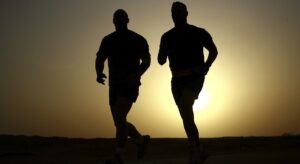The appearance of primitive games and physical exercises, according to the data of archaeological and ethnographic sciences, refers to the first early period of primitive society. In the scientific literature, it is generally accepted that the time of evolution of the most ancient “man of skill” (homo habilis) to the later “man of reason” (homo sapiens) takes several million years in the history of mankind.
Scientists call this period of human formation and society the period of anthroposociogenesis (from the Greek word “anthropos” – human, “genesis” – formation, origin). It came to an end about 30-40 thousand years ago, when the human race was replaced by the Greek term anthroposociogenesis. It was completed about 30-40 thousand years ago, when the forming humans (primates) and the forming society (fore-society) were replaced by homo sapiens (reasonable man) with his physical type close to the modern one, and the formed human society. It is characterized by the development of sound knowledge and a logical way of thinking, the formation of certain norms of behavior, the emergence of totemism, magic, and elements of art. This is the second period of primitive society within the boundaries of 40-12 thousand years B.C. It was then that the technology and economy of the human collective became significantly more complex and a new form of human organization emerged: the primitive clan community.
It is noteworthy that during this period games and primitive physical exercises become an independent kind of human activity.
Biological, cult and labor theories. The problem of the origin of games and physical exercise has long been of interest to scientists in many countries. They approached it in different ways. Some explained the origin of games and physical exercises from cultic and biological positions. Others considered the origin and initial development of physical education in close connection with the labor activity of primitive people.
At the end of the 19th and beginning of the 20th centuries, some scientists – Bücher and Gross (Germany), Spencer (England), Letourneau (France) – argued that labor processes emerged from animal games, without making a distinction between animal and human games. They said that man, like the animal, plays because he has an excess of strength. According to them, in the life of society “play is older than labor,” and “labor is the child of play.
These views of scientists of the late nineteenth century are closely intertwined with the statements of some modern philosophers, sociologists and historians. For example, the German historian K. Diem believed that all physical exercises and games have “cult and animal-like origins”. W. Kerbs (FRG), B. Gillette (France) hold a similar opinion.
However, the labor theory, whose representatives include F. Engels, V.G. Plekhanov, M.O. Kosven, N.I. Ponomarev and a number of other scientists, acquired a greater number of followers.
Ф. Engels, in his work “The Role of Labor in the Process of Turning Monkeys into Men,” wrote that “labor created man himself. It was in the process and as a result of labor, and in the first place hunting, man acquired the necessary skills and abilities in running, jumping, throwing, climbing, developed physical strength, endurance, agility, intelligence.
An important role was also played by the evolution of the ancient man’s consciousness, his spiritual world. Hunting and other vital occupations required specific and sophisticated skills. Not infrequently before going to hunt, a man depicted on a rock or on the ground the animal to be hunted and struck or shot at it with a bow. Performing a particular ritual, the man at the same time tempered the will, developed the accuracy of the eye and accuracy of the hand, acquired the skills necessary in the actual hunt.
The development of thinking, consciousness of the primitive man was a subjective prerequisite for the emergence of physical education in society.
With the appearance of religious cults, elements of physical exercises were often connected with various rituals. So cult dances, dances and games appeared. However, the appearance of physical exercises, games and dancing movements as actions derived from labor belongs to the pre-Religious period of human history.
The geographical environment and climatic conditions in which the primitive people lived played an important role in the origin of these or those kinds of physical exercises and games. Skis have been used by peoples of the North since ancient times for work and everyday life. Tribes that lived on the banks of water bodies adapted to their environment by practicing swimming and rowing, and in winter they rode skates made of long tubular animal bones on ice. Nomadic tribes living in the steppes taught their children to ride from an early age. In the process of improving tools and weapons, under the influence of new forms of economy and as the consciousness of primitive people developed, new physical exercises and games appeared. In the ancestral society, they almost entirely reproduced elementary labor movements and were naturalistic in nature.



